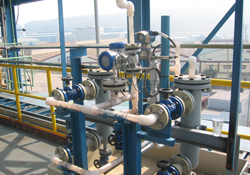Even though it sounds like science fiction, researchers are taking a second look at a controversial idea that uses futuristic ships to shoot salt water high into the sky over the oceans, creating clouds that reflect sunlight and thus counter global warming.
The report card provides information about the current and predicted-future state of Australia's marine climate and its impact on our marine biodiversity. The report card also outlines actions that are underway to help our marine ecosystems adapt to climate change.
Two new studies by scientists at UC Berkeley provide a clearer picture of why some species move in response to climate change, and where they go.
Most of the bacteria that remain in drinking water when it gets to the tap can be traced to filters used in the water treatment process, rather than to the aquifers or rivers where it originated, University of Michigan researchers discovered.

Electromagnetic flowmeters (EMFs) are the leading choice for recording the volume flow of electrically conductive liquids in a wide range of industries, including chemical, pharmaceutical, water/wastewater and food.
The authors of a Harvard study published August 19 in Nature Climate Change gathered their data from an unlikely source -- the trip accounts of the Massachusetts Butterfly Club.
A new “Wind Technologies Market Report” from the U.S. Department of Energy shows how quickly the installation of wind energy equipment progressed in the United States during 2011.
Renewable energy technologies generally consist of two distinct processes: energy generation (using sources such as coal, solar, wind, etc.) and energy storage (such as batteries).
A shipping company headquartered in Italy and the chief engineer of one of its ships were sentenced today in federal court in Mobile, Ala., for deliberately falsifying records to conceal discharges of oily wastewater from the ship directly into the sea.
The report card provides information about the current and predicted-future state of Australia's marine climate and its impact on our marine biodiversity. The report card also outlines actions that are underway to help our marine ecosystems adapt to climate change.
Engineers at a company co-founded by a University of Texas at Dallas professor have identified a material that can reduce the pollution produced by vehicles that run on diesel fuel.
A new carbon cycling model developed at the U.S. Department of Energy's (DOE) Oak Ridge National Laboratory better accounts for the carbon dioxide-releasing activity of microbes in the ground, improving scientists' understanding of the role soil will play in future climate change.
Two new studies by scientists at UC Berkeley provide a clearer picture of why some species move in response to climate change, and where they go.
Melting over the Greenland ice sheet shattered the seasonal record on August 8 – a full four weeks before the close of the melting season, reports Marco Tedesco, assistant professor of Earth and atmospheric sciences at The City College of New York.
Ancient pollen and charcoal preserved in deeply buried sediments in Egypt's Nile Delta document the region's ancient droughts and fires, including a huge drought 4,200 years ago associated with the demise of Egypt's Old Kingdom, the era known as the pyramid-building time.
The changes will result from the South Pacific rain band responding to greenhouse warming. The South Pacific rain band is largest and most persistent of the Southern Hemisphere spanning the Pacific from south of the Equator, south-eastward to French Polynesia.
The U.S. Environmental Protection Agency’s Pacific Southwest Region today announced the 12 winners for the 2012 annual environmental awards to acknowledge significant contributions to protecting the environment.
The mayor of Dallas, Texas, Mike Rawlings, signed a proclamation Aug. 15 declaring a local state of disaster to be in effect for seven days as officials in the city and Dallas County respond to a widespread outbreak of West Nile Virus.
New analysis from Frost & Sullivan, North American Industrial Water and Wastewater Treatment Chemicals Markets, finds that the market earned revenues of $2.03 billion in 2011 and estimates this to reach $2.79 billion in 2018.
A new study led by scientists at the University of York has shown how birds, butterflies, other insects and spiders have colonised nature reserves and areas protected for wildlife, as they move north in response to climate change and other environmental changes.